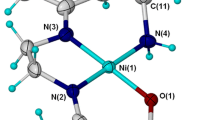Summary
The complexestrans-[Ru(NH3)4(H2O)PPh3](PF6)2 and [Ru(NH3)5L](PF6)2, (L=AsPh3 or SbPh3) have been isolated and characterized by microanalysis, cyclic voltammetry and ultraviolet-visible spectroscopy. The specific rate constants for the aquation of [Ru(NH3)5L]2+ totrans-[Ru(NH3)4L(H2O)]2+ are (2.5±0.1)×10−5s−1 and (1.8±0.1)×10−5s−1 for L=AsPh3 and SbPh3, respectively, at 25.0±0.1°C; μ=0.10 mol dm−3, NaO2CCF3. Under the same conditions, the second-order rate constants for the substitution of water intrans-[Ru(NH3)4(H2O)L]2+ by isonicotinamide (isn) are 1.2±0.1, (6.3±0.3)×10−2 and (3.8±0.2)×10−2 m −1s−1 for L=PPh3, AsPh3, and SbPh3, respectively, suggesting that the order of decreasingtrans-effect is: PPh3≫AsPh3>SbPh3. The formation constants for thetrans-[Ru(NH3)4L(isn)]2+ complexes are 75±3, (1.40±0.01)×103 and (1.80±0.02)×103M−1 for L=PPh3, AsPh3, and SbPh3, respectively, suggesting that the order of increasingtrans-influence is: SbPh3<AsPh3≪PPh3.
Similar content being viewed by others
References
C. Masters,Homogeneous Transition-Metal Catalysis, Chapman and Hall, London, 1981.
J. P. Colman and L. S. Hegedus,Principles and Applications of Organotransition Metal Chemistry, University Science Books, California, 1980.
L. H. Pignolet,Homogeneous Catalysis with Metal Phosphine Complexes, Plenum Press, New York, 1983.
S. D. Robinson,Intern. Rev. Sci., Ser 2,6, 71 (1965).
H. Taube,Comments Inorg. Chem.,1, (1981) and refs. therein.
D. W. Franco and H. Taube,Inorg. Chem.,17, 571 (1978) and refs. therein.
J. C. Nascimento Fo and D. W. Franco,Inorg. Chem. Acta,113, (1986).
R. E. Sheperd and H. Taube,Inorg. Chem.,12, 1392 (1973).
F. A. Cotton and G. Wilkinson,Advanced Inorganic Chemistry, 4th Edit., Interscience Publishers, New York, 1980.
H. S. Lim, D. J. Barclay and F. Anson,Inorg. Chem.,11, 1460 (1972).
J. A. Marchant, T. Matsubara and P. C. Ford,Inorg. Chem.,16, 2160 (1977).
C. A. Tolman,Chem. Rev.,77, 340 (1977).
J. H. Espenson,Chemical Kinetics and Reaction Mechanisms, McGraw-Hill Book Co., New York, 1981.
L. H. Vogt, J. L. Katz and S. E. Wiberley,Inorg. Chem.,4, 1157 (1965).
C. G. Kuehn and H. Taube,J. Am. Chem. Soc.,98, 689 (1976).
R. G. Wilkins,The Study of Kinetics and Mechanism of Reactions of Transition Metal Complexes, Allymand Bacon, Inc., Boston, 1974.
F. Basolo and R. G. Pearson,Mechanisms of Inorganic Reactions, Wiley and Sons, Inc., New York, 1967.
Author information
Authors and Affiliations
Rights and permissions
About this article
Cite this article
de Rezende, J.M., Franco, D.W. Preparation, characterization and a kinetic study oftrans-[Ru(NH3)4L(H2O)](PF6)2 [L=PPh3, AsPh3, or SbPh3]. Transition Met Chem 12, 267–270 (1987). https://doi.org/10.1007/BF01023546
Received:
Revised:
Issue Date:
DOI: https://doi.org/10.1007/BF01023546



